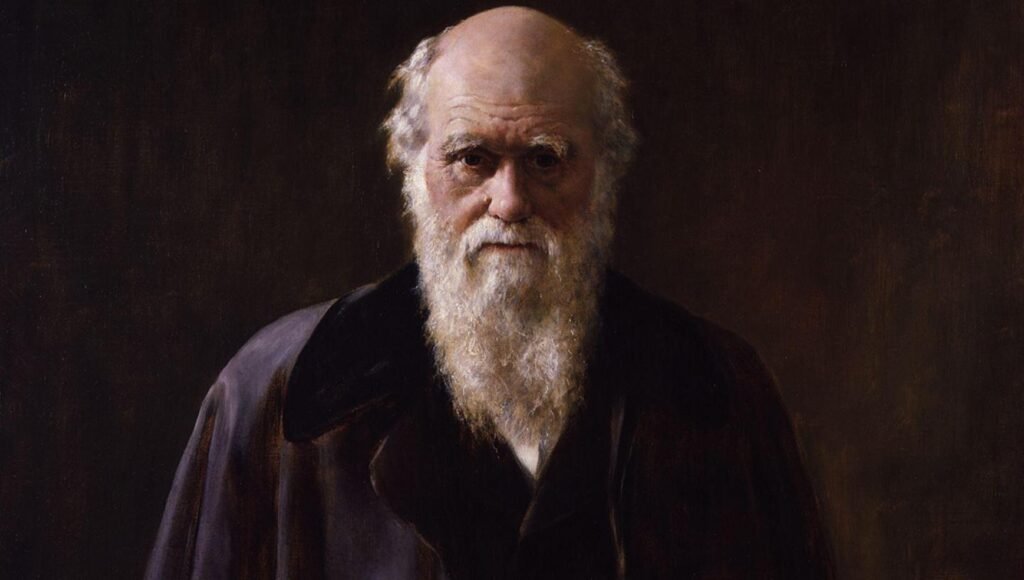
Brief Overview
Known predominantly for his revolutionary ideas in the realm of biology, Charles Darwin was a groundbreaking 19th-century English naturalist. He was born on February 12, 1809, and devoted his life to studying the natural world, with his pioneering theories of natural selection and evolution drastically altering our understanding of nature’s dynamics.
His most significant work, “On the Origin of Species“, asserts that all species of life have descended over time from common ancestors, an idea that sparked considerable controversy but eventually became the foundation of evolutionary biology. Despite facing numerous criticisms, Darwin persisted, making profound contributions to various scientific fields and leaving a legacy that continues to inform and influence contemporary scientific thought.
Early Life and Education
Childhood and Early Interests
Born on February 12, 1809, in Shrewsbury, England, Charles Robert Darwin was the fifth of six children in a wealthy doctor’s household. His fascination for the natural world was evident even at an early age. As a young boy, he developed a particular interest in collecting and studying various biological specimens, which was nurtured by his mother. Though she passed away when he was only eight, her influence on his naturalist inclinations was quite profound.
Darwin’s fascination for the natural environment amplified when his father sent him to the nearby Shrewsbury School; he often found himself engrossed in observations of flora and fauna more than his assigned studies. This affinity for exploration and observation laid the groundwork for his later works and discoveries in the fields of naturalism and evolution. His intellectual curiosity was further fueled by the ample evidence of geological processes he observed during family holidays to the Welsh coast.
Education and Formative Years
Charles Darwin received his early formal instruction at Shrewsbury School in England, a rigorous institution that provided a solid foundational education. However, it was at the University of Edinburgh that his strong inclination for the natural sciences took root. Initially enrolled as a medical student in 1825, Darwin found hospital scenes too distressing and surgeries held without anesthesia during that period intolerable. He shifted his focus towards natural history, attended lectures on geology and botany, and started participating in student natural history collections.
Darwin’s growing interest in scientific inquiry led him to transfer to Christ’s College at the University of Cambridge in 1827, aiming to become a clergyman, as it left ample spare time for natural history studies. His passion for observing nature and collecting specimens formed during these years, which was instrumental in shaping his future theoretical developments. Darwin’s years of training for the clergy, immersed in theology and expected to uphold the truth of Biblical creation, paradoxically acted as a catalyst in formulating his groundbreaking Theory of Evolution.
Voyage of the Beagle
Purpose and Significance of the Voyage
Embarking on what would later be recognized as a significant journey in the history of science, Darwin set sail on the HMS Beagle in 1831. With the principal aim of conducting geographical survey work, the trip had far-reaching implications beyond its initial cartographic purpose. The five-year voyage provided Darwin with the opportunity to investigate diverse biological species in distinct ecological habitats all over the globe.
His keen observations and systematic recording of the array of variegated fauna and flora he encountered served as the foundation for his revolutionary theory of natural selection. Hence, the journey’s significance lies not only in its geographical contributions but also in the critical role it played in stimulating Darwin’s thoughts, eventually culminating in his groundbreaking work, ‘Origin of Species’. The voyage of the beagle is central to understanding Darwin’s transformation from a curious naturalist into a scientific trailblazer.
Observations and Discoveries
Commencing a five-year mission around the world in 1831 aboard the HMS Beagle, Darwin gathered a wealth of data that oscillated conventional thought. This expedition granted Darwin the ideal milieu to observe various species and their geographical distribution, the foundation of his revolutionary theory. Of particular impact was his visit to the Galapagos Islands, where he noted the distinct variations between species on different islands. For example, he found that the shape and size of a finch’s beak varied from one island to another, forging an inference that it had adapted to the specific food sources available.
Additionally, he discovered unique species that only existed in specific regions, fostering ideas about species evolution and extinction. The myriad observations and findings made during this voyage formed the fundamental basis of his groundbreaking work, “On the Origin of Species.” The knowledge he acquired from this exploration significantly reshaped scientific understanding and ignited a radical shift in the discourse on natural history and evolution.
Formulation of Evolutionary Theory
Darwin’s Inspiration and Preliminary Thoughts
In the mid-1800s, Charles Darwin was galvanized by a fascinating voyage. The H.M.S. Beagle journey of five years played a pivotal role in kindling his fascination with the variation in species and the influence of the natural environment on their survival. During this voyage, he had the opportunity to observe an array of organisms across diverse ecological settings, their interactions with the environment, and the adaptations they acquired over generations to survive. Observing species and their variations in the Galapagos archipelago was particularly transformative for him. There was a moment of eureka when he was examining the intricacies of finches.
Darwin noticed that the finch species on different islands had differently adapted beaks, perfectly suited for the type of food available on their respective islands. This was the preliminary spark that ignited the fire within him, leading to the formulation of my unprecedented theory of evolution. This concept of natural selection became clearer when he studied Thomas Malthus’ work, which contemplated population growth’s impact on food scarcity, further refining his theory. The amalgamation of these experiences and observations ultimately led to the consolidation of his theory, which suggested that species evolve over generations through a process of natural selection.
Introduction to Natural Selection
In the early 19th century, Charles Darwin developed one of the most influential theories in the realm of biology: natural selection. The concept postulates that organisms with traits best suited to their environment are more likely to survive and reproduce, thereby passing on these advantageous attributes to their offspring. This process, unfolding over many generations, results in evolutionary changes in the species. Darwin’s theory, although controversial at the time, was a groundbreaking revelation that drastically altered the way we comprehend life on Earth.
Notably, it provides an explanation for the abundant diversity observed in nature, helping us to understand why and how different organisms possess specific physical characteristics or behaviors. Darwin arrived at these conclusions through extensive observations of nature during his voyage on the HMS Beagle, most significantly during his visit to the Galapagos Islands. The variability among similar species in different conditions on the islands played a crucial role in shaping Darwin’s ideas about adaptation and evolution.
Publication of ‘On the Origin of Species’
Initial Reactions and Controversies
When ‘On the Origin of Species’ first saw the light of day in 1859, it sparked an array of reactions, much of them controversial. Scholarly debates were ignited over the theory of natural selection, central to Darwin’s assertions. While contrarian thought was prevalent, the book also found many advocates, especially among younger naturalists who were quick to champion these new ideas.
However, the driving atmosphere was one of contestation; theologians, particularly, took umbrage at the undermining of literal interpretations of biblical stories like the creation of man. Many members of the general public, too, balked at the implication of being biologically related to apes. The very integrity of the natural sciences was at the heart of the bifurcation, marking an era of profound and lasting change in the scientific landscape.
Impact and Legacy of the Book
The enduring influence of Darwin’s magnum opus is nothing short of significant. Unveiled to the public in 1859, the book challenged and disrupted long-standing beliefs, bringing about a radical shift in the way we perceive the biological world. Its core argument—that living organisms evolved over time through a process he termed natural selection—continues to be a key pillar of modern biology.
The revolutionary text catapulted Darwin to the forefront of scientific discourse and has since been a source of intellectual and philosophical discussion. Today, nearly two centuries later, his ideas continue to resonate. This testament to time portrays Darwin’s remarkable impact and legacies in scientific thought, propelling forward ongoing research in evolution, genetics, and other related fields. Such is the magnitude of his book’s influence that it notably remains a cornerstone of contemporary biological education and research.
Later Life and Death
Contributions Outside of Evolution Theory
Even though Charles Darwin is primarily recognized for his contributions to the theory of evolution, his scientific impact goes far beyond that domain. His abilities to keenly observe, record, and analyze proved beneficial in some other curious yet significant areas of biology. Darwin carried out pioneering work pertaining to plant biology and botany.
He wrote several books on the subject, notably ‘The Variation of Animals and Plants under Domestication’ and ‘The Effects of Cross and Self Fertilization in the Vegetable Kingdom’. These works advanced knowledge regarding the reproduction of plants and the role of natural selection in their development and survival. Apart from this, his experiments in biogeography led to new data on the distribution and adaptability of species. For instance, his extensive research and observations on earthworms and their impact on soil fertility laid the foundation of modern soil science.
Thus, Darwin’s curiosity led him to explore and contribute to multiple facets of the biological sciences, emphasizing his multi-dimensional intellect and passion for understanding the natural world. Later in his life, Darwin suffered from various health issues and passed away on April 19, 1882. However, his scientific legacy continues to thrive and influence contemporary biology and related sciences.
Family Life, Health and Death
Amidst incredible contributions to science, Darwin led a personal life filled with responsibilities towards a blooming household. In 1839, he tied the knot with his cousin, Emma Wedgwood, and they went on to have ten children. Seven of these children survived infancy and carried on to lead impactful lives, with some making significant contributions in the fields of botany and literature. However, Darwin’s health deteriorated significantly after his voyages.
He experienced regular bouts of illness that some historians suggest may have been a result of Chagas disease, a condition he contracted during his voyage on the HMS Beagle. Despite his frail health, Darwin continued to work on his theories and publish multiple editions of his work. Unfortunately, his health progressively worsened, leading to his death at the age of 73 on April 19, 1882. He was interred at Westminster Abbey, close to two other prominent scientists, Sir Isaac Newton and.
Legacy of Charles Darwin
Darwin’s Impact on Science and Society
Charles Darwin’s influence has permeated both the scientific community and greater society, transforming the way we understand and interpret the natural world. His theory of evolution by natural selection, detailed in his groundbreaking work ‘On the Origin of Species’, provided an innovative and compelling explanation for the diversity and complexity of life.
This shifted the paradigms of the scientific world, encouraging a more critical and evidence-based approach towards the concepts of biology and life sciences. Furthermore, the societal implications of his work continue to resonate through the years, urging humanity to reevaluate entrenched beliefs and norms. An instrumental figure in encouraging this enlightenment and rational thinking, Darwin’s contributions have undoubtedly cemented his status as one of the most influential figures in history.
Modern Perspectives on Darwin’s Work
In contemporary scientific and scholarly society, Charles Darwin’s contributions are highly esteemed and serve as fundamental concepts in various fields. His theory of natural selection, presented in his seminal book “On the Origin of Species,” challenged the traditional explanation of creation and revolutionized the biological sciences. This transformative work laid the groundwork for an entirely new understanding of life’s complexity and biodiversity. Additionally, it ignited diverse debates among religious, philosophical, and scientific circles about the nature of human existence and the universe.
His theory’s interdisciplinary implications have fostered cross-pollination of ideas among distinct disciplines, connecting fields like biology, genetics, anthropology, philosophy, and sociology. Darwin’s work remains a critical reference point, shaping modern interpretations of evolution, inspiring new research questions, and offering pragmatic solutions for conservation issues. Today, as we unlock the secrets of DNA and the genome, Darwin’s principles continue to guide our understanding, thereby attesting to their enduring relevance.



